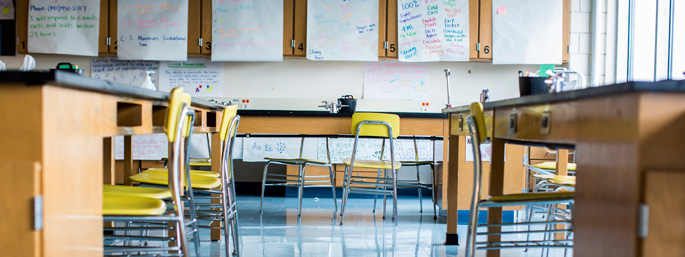Today, the Senate confirmed Dr. Miguel Cardona as the 12th U.S. Secretary of Education. In the letter below, TNTP’s CEO Dan Weisberg and Javaid Siddiqi, President & CEO of The Hunt Institute, call on Secretary Cardona and President Biden to focus on two bold priorities: adding one million new teachers of color to our schools in the next decade, and accelerating students back to grade level.
If you’d like to help us call on the administration to focus on teacher diversity and learning acceleration, you can add your name to the letter we’ll deliver to Secretary Cardona.
***
Dear Secretary Cardona,
Congratulations on your confirmation as Secretary of Education. With the COVID-19 pandemic continuing to cause unprecedented disruption to P-20 education across the country, strong leadership at the Department has never been more critical.
Conversation about this crisis has mostly focused on the logistics of reopening school buildings safely, and the urgent need for federal funds to make that possible. While that should be a top priority as part of a broader stimulus package and COVID-19 response plan, the federal response on education shouldn’t end there.
Even after students are back in classrooms, schools will need to help them make up for tremendous losses in learning, even as they face the prospect of significant budget cuts. One widely-cited study predicted that students will see a learning loss of 30 percent in reading and 50 percent in math as a result of the pandemic. These setbacks have exacerbated fundamental inequities that have already disproportionately affected students of color, those from low-income families, those learning English, and those with special needs—a challenge President Biden highlighted as a candidate.
Especially during this national moment of reckoning with systemic racism, we believe the federal government should take a leading role in helping schools address these inequities now and over the long run. A robust federal response would not only support a generation of students at risk of falling behind, but would represent a landmark investment in workforce development for talented people—especially people of color—who’ve seen ladders to the middle class dwindle since the Great Recession (and long before). The agenda for the first term of the Biden-Harris Administration should include bold legislative and regulatory initiatives to do just that, focusing on two bold priorities: adding one million new teachers of color to our schools in the next decade, and accelerating students back to grade level.
One Million New Teachers of Color in the Next Decade
To help students accelerate back to grade level after the disruption of the pandemic, schools will need more great teachers than ever. And as a growing body of research and years of advocacy by civil rights organizations and education leaders of color has shown, the U.S. has an especially urgent need for teachers of color. It’s why President Biden made improving teacher diversity a key part of his education agenda as a candidate. He now has an opportunity to put his campaign pledge into action and develop “innovative approaches to recruiting teachers of color” into action at a pivotal moment for the country.
While all students benefit from having teachers of color—in the form of greater engagement, higher achievement, and cross-cultural interactions—the benefits are most significant for students of color. Students with the same racial or ethnic background as their teacher are more likely to complete high school and go to college, less likely to be suspended, and more likely to be referred to gifted and talented programs. For Black students, having just one Black teacher in elementary school can improve their lives far into adulthood.
Yet across the country, teachers don’t look like the students they serve. While 53 percent of students in the United States identify as people of color, 80 percent of teachers are white. And 40 percent of public schools don’t have a single teacher of color. Without immediate action, this teacher diversity gap will widen as schools lay off teachers to close looming budget deficits, since “last-in, first-out” layoff rules often disproportionately affect teachers of color.
At a time when the nation is reckoning with racial injustice, federal leadership and resources could help close the teacher diversity gap by sparking an enormous infusion of talented people of color into our schools, many of whom are already supporting students as paraprofessionals or caregivers. It’s an effort that could provide critical support for the students most affected by the pandemic, drive educator-focused workforce initiatives, create new pathways to the middle class for people of color and professionals whose jobs disappeared in recent months, address chronic teacher shortages in high-need subject areas—and, most importantly, help build a more equitable public education system over the long run.
Recommendations
- The administration should set a goal to have one million more teachers of color—enough for the national teaching workforce to mirror the demographics of students— by the end of the decade, through a combination of hiring new teachers and retaining current teachers at higher rates. This would mean a two-to-three-fold increase in the number of Black, Latinx, Asian-American, and American Indian/Alaska Native teachers.
- Because strong school leaders of color play an important role in recruiting and retaining teachers of color, the administration should also commit to a two-to-three-fold increase in the number of principals of color by the end of the decade.
- Congress should fund a grant program for states that commit to contributing proportionately to this educator diversity goal. Grants would be directed toward:
- Stipends of up to $5,000 for teacher and principal candidates of color who commit to teaching or leading in Title I-eligible public schools for at least three years
- Student loan forgiveness for teachers after serving 3-5 years in Title-I eligible public schools
- Targeted home buyer assistance programs for teachers who choose to purchase homes in the districts in which they teach
- Financial and logistical support for educators of color hoping to earn National Board Certification
- Training and financial assistance for Opportunity and Counseling Corps members (see below), paraprofessionals, uncertified childcare educators, and other school support staff to attain undergraduate degrees and teaching certification
- Growth capital to help education programs in HBCUs and Minority Serving Institutions expand
- Retention programs targeting educators of color through mentoring, affinity groups, career pathways (for those not interested in pursuing school leadership roles), and retention bonuses based on effectiveness
- Design and implementation of performance-based alternatives to teacher certification exams, which disproportionately screen out teachers of color without consistently predicting future effectiveness
- Development of diversity goals for educator preparation programs, with accompanying support and accountability systems
Accelerating Every Student Back to Grade Level—and to Postsecondary Success
Even under normal circumstances, schools struggle mightily to help students get back to grade level after they’ve fallen behind. Now that they’re facing more students who are farther behind than ever before, they need to get dramatically better at catching students up—and do it quickly. At the same time, they’ll need to help students and teachers cope, socially and emotionally, with the trauma they’ve experienced from the ongoing public health and economic crises.
As a candidate, President Biden pledged to make closing the COVID-19 educational equity gap a top priority of his administration, focusing on evidence-based policy solutions to address learning gaps.
On the academic front, this means redirecting time and funding away from the traditional notion of “remediation,” which rarely gives students an opportunity to engage with grade-level work, even when they’re capable of tackling it with the right supports. In fact, when students who are behind get opportunities to do grade-appropriate work along with relevant, engaging instruction, research shows they make great strides—their learning accelerates.
The Biden Administration should prioritize helping states shift from remediation to acceleration, so that all students—especially historically marginalized students who have most often been relegated to remedial classes—can be on track for postsecondary success.
Recommendations
- The administration should set a clear goal to have all students on track to graduate high school ready for college or a good-paying job by 2026.
- Congress should establish a grant program for states that commit to have all students on track for postsecondary success by 2026. Grant funds would support:
- An Opportunity and Counseling Corps to supplement instruction and emotional support in classroom and outside of school, with a preference for residents of underserved communities interested in teaching careers. This program could work in conjunction with established national service corps (Americorps, ServiceCorps, etc.)
- Stipends for master teachers to train and, where necessary, supervise Corps members
- Funding for extended learning/enrichment time outside of regular school hours
- Supplemental Title II, Title III, and IDEA funding for educator training on high-quality curricula and learning acceleration strategies, including specific strategies for multi-lingual learners and students with special needs, and for remote instruction
- New approaches to assessments (both academic and non-cognitive), to ensure that schools have the timely information about students’ progress they need—disaggregated by demographics—to accelerate learning. These could include online assessments that can be taken remotely and at the student’s pace, or online student and family surveys to capture better information about their school experiences.
- Clear information for parents on students’ academic and non-cognitive progress and status against postsecondary goals, with student-specific strategies on how to support learning acceleration at home








